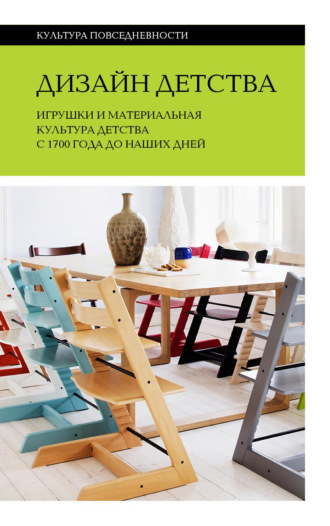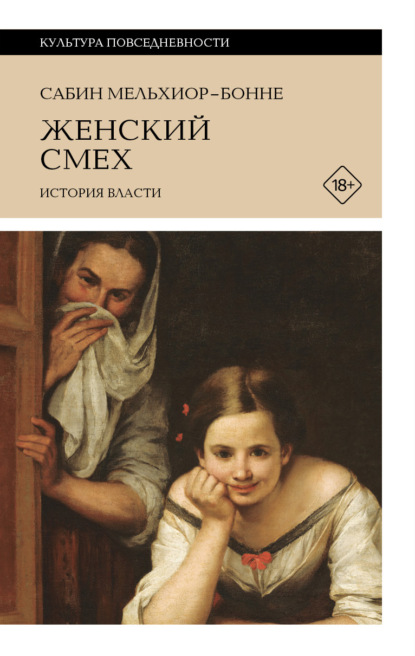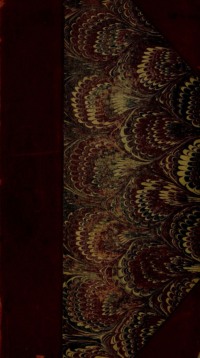
Полная версия
Дизайн детства. Игрушки и материальная культура детства с 1700 года до наших дней
15
Ibid. P. 48; Brewer J. Childhood Revisited. P. 33.
16
Локк предложил нанести на кубики буквы алфавита.
17
Brewer J. Childhood Revisited. P. 35–36; Brewer J. Educational Toys in America: 1800 to the Present / ed. by Karen Hewitt and Louise Roomet. Burlington: The Robert Hull Fleming Museum/University of Vermont, 1979. P. 38; Plumb J. The New World of Children in Eighteenth-Century England // The Birth of a Consumer Society: The Commercialization of Eighteenth-Century England / ed. by Neil McKendrick, John Brewer, and J. H. Plumb. Bloomington: Indiana University Press, 1985. P. 286–315.
18
Calvert K. Children in the House. P. 7. Цит. по: Калверт К. Указ. соч. С. 14.
19
Ibid. P. 27–38; Kevill-Davies S. The Wide World // Kid-Size: The Material World of Childhood, Alexander von Vegesack, foreword. Milan: Skira Editore/Vitra Design Museum, 1997. P. 51–54.
20
Ottlinger E. Children’s Furniture, Nurseries and an Imperial Childhood // Fidgety Philip! A Design History of Children’s Furniture / ed. by Eva B. Ottlinger. Vienna: Böhlau, 2006. P. 25–33.
21
Boehn M. Puppen und Puppenspiele. München: Bruckmann, 1929. Коллекционер и историк искусства Констанс Эйлин Кинг оспаривала положение Бёна о том, что у кукол в древнем мире были преимущественно культовые функции. И хотя она соглашалась с ним в том, что главная и самая древняя функция кукол – это поклонение, Кинг все же настаивала, что дети, подчиняясь естественному стремлению подражать взрослым, делали собственных кукол, наподобие взрослых идолов. Кинг предполагала, что существовали куклы низшего порядка, которых, по-видимому, делали родители или сами дети, копируя религиозных идолов (King C. Dolls and Dolls’ Houses. N.Y.: Hamlyn, 1977). – Примеч. автора.
22
Cross G. Kids’ Stuff: Toys and the Changing Worlds of American Childhood. Cambridge: Harvard University Press, 1997. P. 14.
23
Rogers M. Barbie Culture. L.: Sage, 1999; Rand E. Barbie’s Queer Accessories. Durham and L.: Duke University Press, 1995.
24
Peers J. Adelaide Huret and the Nineteenth-Century French Fashion Doll: Constructing Dolls/Constructing the Modern // Dolls Studies: The Many Meanings of Girls Toys and Play / ed. by Miriam Forman-Brunell and Jennifer Dawn Whitney. N. Y.: Peter Lang, 2015. P. 171.
25
Fleming D. Powerplay: Toys as Popular Culture. Manchester: Manchester University Press, 1995. P. 42.
26
Forman-Brunell M. Interrogating the Meanings of Dolls: New Directions in Doll Studies // Girlhood Studies. 2012. No. 1 (5). P. 3–13. Также см.: Rand E. Barbie’s Queer Accessories; Chin E. Ethnically Correct Dolls: Toying with the Race Industry // American Anthropologist. 1999. No. 2 (101). P. 305–321; Chin E. Purchasing Power: Black Kids and American Consumer Culture. Minneapolis: University of Minnesota Press, 2001; duCille A. Black Barbie and the Deep Play of Difference // The Feminism and Visual Culture Reader / ed. by Amelia Jones. L.: Routledge, 2003. P. 337–348; duCille A. Dyes and Dolls: Multicultural Barbie and the Merchandising of Difference // Differences: A Journal of Feminist Cultural Studies. 1994. No. 4 (6). P. 46–68; Inness S. Anti-Barbies: The American Girls Collection and Political Ideologies // Delinquents and Debutantes: Twentieth-Century American Girls’ Cultures / ed. by Sherrie Inness. N. Y.: New York University Press, 1998. P. 164–183. Работа Мириам Форман-Брунелл частично повлияла на новое поле феминистских исследований куклы. Ее работа 1998 года Made to Play Home поставила под вопрос распространенное убеждение в том, что девочки рабски придерживались той формы игры с куклой, какую предписывали патриархальные гендерные идеалы. См.: Forman-Brunell M. Made to Play House: Dolls and the Commercialization of American Girlhood, 1830–1930. Baltimore, MD: Johns Hopkins University Press, 1998.
27
Lindencrona B. Dollhouses and Miniatures in Sweden // Swedish Wooden Toys / ed. by Amy Ogata and Susan Weber. New Haven: Yale University Press, 2014. P. 187–215.
28
Шкаф, горка, в котором стояли куклы и другие игрушки.
29
Broomhall S. Imagined Domesticities in Early Modern Dutch Dollhouses // Parergon. 2007. No. 2 (24). P. 52.
30
Lindencrona B. Dollhouses and Miniatures in Sweden. P. 188.
31
Broomhall S. Imagined Domesticities. P. 55.
32
Wilckens von L. Mansions in Miniature: Four Centuries of Dolls’ Houses. N. Y.: Viking Press, 1980. P. 57.
33
Jaffé D. The History of Toys: From Spinning Tops to Robots. L.: Sutton Publishing, 2006. P. 158–159.
34
Jacobs F. G. A History of Dolls’ Houses. N. Y.: Charles Scribner’s Sons, 1965. P. 28; Müller H. Ein Idealhaushalt im Miniaturformat: Die Nürnberger Puppenhäuser des 17. Jahrhunderts. Nürnberg: Verlag des Germanischen Nationalmuseums, 2006. P. 19–23.
35
Cook D. The Commodification of Childhood: The Children’s Clothing Industry and the Rise of the Child Consumer. Durham: Duke University Press, 2004; Pugh A. Longing and Belonging: Parents, Children, and Consumer Culture. Berkeley: University of California Press, 2009.
36
Seiter E. Sold Separately: Parents and Children in Consumer Culture. New Brunswick: Rutgers University Press, 1993. P. 66.
37
Zelizer V. Pricing the Priceless Child: The Changing Social Value of Children. N. Y.: Basic Books, 1985.
38
Здесь и далее в оригинале – empowered child, что отсылает также к понятию эмпауэрмента в педагогике (это педагогический подход, предполагающий мотивацию учащегося к действиям и принятию собственных решений). – Примеч. ред.
39
Schor J. Born to Buy: The Commercialized Child and the New Consumer Culture. N. Y.: Scribner, 2004; Linn S. Consuming Kids: The Hostile Takeover of Childhood. N. Y.: The New Press, 2004; Kline S. Out of the Garden: Toys and Children’s Culture in the Age of Television Advertising. N. Y.: Verso, 1993. P. 107–143; Kinderculture: The Corporate Construction of Childhood / ed. by S. Steinberg. Boulder, CO, 2011.
40
Seiter E. Sold Separately; Buckingham D. The Material Child: Growing up in Consumer Culture. Cambridge: Polity Press, 2011; Buckingham D., Tingstad V. Childhood and Consumer Culture. L.: Routledge, 2010; Pugh A. Longing and Belonging: Parents, Children, and Consumer Culture. Berkeley: University of California Press, 2009; Lindstrom M., Seybold P. Brain-Child: Remarkable Insights into the Minds of Today’s Global Kids and Their Relationships with Brands. L.: Kogan Page, 2003; The Children’s Culture Reader / ed. by H. Jenkins. N. Y.: New York University Press, 1998.
41
См., например: Allison J. Confections, Concoctions, and Conceptions // The Children’s Culture Reader. P. 394–405.
42
Schor J. Born to Buy. P. 51–55.
43
Kline S. Out of the Garden. P. 143.
44
Об этой дискуссии можно почитать у Эллен Зайтер (Seiter E. Sold Separately: Parents and Children in Consumer Culture. New Brunswick: Rutgers University Press, 1993). В этой книге автор отстаивает точку зрения, что детское потребление часто связано с желанием быть принятым в группе сверстников и освободиться от власти взрослых. Из-за этого дети подражают своим сверстникам, которые вовсе не обязательно следуют взрослым образцам классового и расового потребления. – Примеч. автора.
45
Cross G. The Cute and the Cool: Wondrous Innocence and Modern American Children’s Culture. Oxford: Oxford University Press, 2004. P. 12.
46
Goldstein J., Buckingham D., Brougére G., eds. Toys, Games and Media. L.; Mahwah, NJ: Lawrence Erlbaum Publishers, 2004; Kids’ Media Culture / ed. by M. Kidner. Durham: Duke University Press, 1999. О мультфильмах см.: Seiter E. Sold Separately; Television and New Media Audiences. N. Y.: Oxford University Press, 1998; а также Seiter E. Power Rangers at Preschool: Negotiating Media in Childcare Settings // Kids’ Media Culture. P. 239–262.
47
Cross G. The Cute and the Cool. P. 31.
48
В оригинале – pester power. Продавцы рассчитывают, что дети надоедливыми просьбами вынудят родителей сделать покупку.
49
Kline S. Out of the Garden. P. 143–173.
50
Program-Length Commercials – «реклама длиной в передачу»; рекламный ролик, который выглядит и воспринимается как мультфильм.
51
Cross G. Kids’ Stuff. P. 188–227.
52
Fleming D. Powerplay: Toys as Popular Culture. Manchester: Manchester University Press, 1995. P. 112–113.
53
Jacobson L. Raising Consumers: Children and the American Mass Market in the Early Twentieth Century. N. Y.: Columbia University Press, 2004; Denisoff D. The Nineteenth-Century Child and Consumer Culture. Burlington: Ashgate, 2008.
54
Jacobson L. Raising Consumers. P. 127–159.
55
Tween – ребенок от 8 до 12 лет, еще не достигший подросткового возраста.
56
Cook D. The Commodification of Childhood: The Children’s Clothing Industry and the Rise of the Child Consumer. Durham: Duke University Press, 2004; Cook D. Commercial Enculturation: Moving Beyond Consumer Socialization // Buckingham and Tingstad, Childhood and Consumer Culture. P. 63–79.
57
Cook D. Commercial Enculturation. P 71.
58
Marshall E. Young Women, Femininities and American Girl // Girlhood Studies. 2009. No. 1 (2). P. 94–111; Acosta-Alzuru C., Kreshel P. ‘I’m an American Girl… Whatever That Means’. Girls Consuming Pleasant Company’s American Girl Identity // Journal of Communication. 2002. No. 1 (52). P. 139–161; Acosta-Alzuru C., Roushanzamir E. ‘Everything We Do Is A Celebration of You!’. Pleasant Company Constructs American Girlhood // The Communication Review. 2003. No. 6. P. 45–69; Brookfield M. From American Girls into American Women: A Discussion of American Girl Nostalgia // Girlhood Studies. 2012. No. 1 (5). P. 57–75.
59
Nielsen F. American History through the Eyes of the American Girls // Journal of American and Comparative Cultures. 2002. No. 1–2 (25). P. 85–93; Marcus L. Dolling up History: Fictions of American Jewish Girlhood // Girlhood Studies. 2012. No. 1 (5). P. 14–36; Inness S. Anti-Barbies. P. 164–183; Lamb S., Brown L. Packaging Girlhood: Rescuing Our Daughters from Marketers’ Schemes. N. Y.: St. Martin’s Press, 2006.
60
«Милая маленькая книжечка» считается одной из первых детских книг. В ней напечатаны простые детские стихи на каждую букву алфавита.
61
Bernstein R. Children’s Books, Dolls and the Performance of Race: or the Possibility of Children’s Literature // Dolls Studies. P. 4.
62
Wolf M. Adapting the Death Star into LEGO: the Case of Lego Set #10188 // LEGO Studies: Examining the Building Blocks of a Transmedial Phenomenon / ed. by M. Wolf. L.: Routledge, 2015. P. 15–39. О LEGO также см.: Konzack L. The Cultural History of LEGO // LEGO Studies. P. 1–14; Robertson D. Brick by Brick: How LEGO Rewrote the Rules of Innovation and Conquered the Global Toy Industry. N. Y.: Crown Business, 2013; Baichtal J., Meno J. The Cult of LEGO. San Francisco, CA: No Starch Press, 2011; Herman S. A Million Little Bricks: The Unofficial Illustrated History of the LEGO Phenomenon. N. Y.: Skyhorse Publishing, 2012.
63
Отдельные наборы были предназначены для девочек, как, например, серия LEGO «Friends» 2012 года выпуска (которая, вероятно, должна была ассоциироваться с истинно девичьим желанием играть в сказочные ролевые игры и оформление интерьера). В наборе были представлены кубики пастельных тонов и женственные фигурки наподобие кукол, иного размера, чем в остальных наборах. Эти конструкторы продавались уже не в «синем» гендерно-нейтральном уголке LEGO, а в отдельном «розовом» потребительском уголке, рядом с Барби. Новый гендерно ориентированный маркетинг и игровые сценарии LEGO подверглись коллективной критике на феминистских ресурсах за то, что наборы, сосредоточенные на гетеронормативных темах (красота, дом, готовка и верховая езда), ограничивают творчество по сравнению с конструкторами для мальчиков (предполагающими сражения и приключения). В феминистских соцсетях разошлась картинка с двумя рекламами LEGO: на изображении 1981 года девочка держит в руках постройку из LEGO свободной формы, а в 2014 году девочка держит гендерно окрашенную игрушку из линейки Friends. Второе фото снабжено провокативной подписью: «В чем разница?» – Примеч. автора.
64
Также см.: Johnson D. Chicks with Bricks: Building Creativity Across Industrial Design Cultures and Gendered Construction Play // LEGO Studies / ed. by M. Wolf. P. 81–104. О критике, казалось бы, нейтральной расовой идентичности желтых фигурок конструкторов LEGO см.: Johnson D. Figuring Identity: Media Licensing and the Racialization of LEGO Bodies // International Journal of Cultural Studies. 2014. No. 4 (17). P. 307–325
65
Zinguer T. Architecture in Play: Imitations of Modernism in Architectural Toys. Charlottesville; L.: The University of Virginia Press, 2015. P. 62.
66
Хотя конструктор позволял создавать бессчетное множество конфигураций, рекламные материалы и инструкция склоняли к выбору определенных исторических архитектурных стилей (в частности, романского стиля и готики) и определенных построек: замков, соборов и крепостей. Историки игрушек Бренда и Роберт Вейл оспаривают утверждение Тамар Зингер, что этот конструктор предвосхитил техническое развитие модернизма. По их мнению, конструктор служил отражением тех предпочтений, которые немецкое общество тех лет отдавало романскому стилю и готике, и был связан с мифом о прошлом Германии, процветавшим в период объединения земель. Vale B., Vale R. Architecture on the Carpet: The Curious Tale of Construction Toys and the Genesis of Modern Buildings. L.: Thames and Hudson, 2013. P. 24–37. – Примеч. автора.
67
Shubert H. Toys and the Modernist Tradition // Toys and the Modernist Tradition. Montreal: Canadian Center for Architecture, 1993. P. 18.
68
Ibid. P. 28.
69
Rose J. The Case of Peter Pan, or The Impossibility of Children’s Fiction. Philadelphia: University of Pennsylvania Press, 1984. P. 1–2.
70
Brandow-Faller M. ‘An Artist in Every Child – A Child in Every Artist’. Artistic Toys and ‘Art for the Child’ at the Kunstschau 1908 // West 86th: A Journal of Decorative Arts, Design History, and Material Culture. 2013. No. 2 (20). P. 195–222; Brandow-Faller M. Child’ s Play? Memory and Nostalgia in the Toys of the Wiener Werkstätte // Journal of Decorative and Propaganda Arts. 2015. No. 27. P. 148–171; Brandow-Faller M. Kinderkunst between Vienna and Brussels 1900: Child Art, Primitivism and Patronage, in Vienna Brussels 1900 / ed. by H. Mittelbauer, P. Defraeye. Leiden: Brill Academic Press, 2018.
71
См. важную монографию Эми Огаты: Ogata A. Designing the Creative Child: Places and Playthings in Midcentury America. Minneapolis: University of Minnesota Press, 2013. В ней говорится, что прогрессивные игрушки и культура дизайна сыграли важную роль в формировании культурных норм послевоенного культа творческого ребенка.
72
См.: Grant J. Raising Baby by the Book: The Education of American Mothers. New Haven: Yale University Press, 1998. P. 201–244.
73
В переводе с нем. «кукольная кухня».
74
Глиняная или литая шкатулка в виде или головы сидящего человека, или в виде целой сценки. Монетка падала в щель и приводила в действие механизм, отчего фигура смешно двигалась.
75
Barton C., Somerville K. Play Things: Children’s Racialized Mechanical Banks and Toys, 1880–1930 // International Journal of Historical Archaeology. 2012. No. 1 (16). P. 47–85; Barton C., Somerville K. Historical Racialized Toys in the United States. N. Y.: Routledge, 2016.
76
«Шани и ее друзья» – бренд, под которым выпускались Барби-афроамериканки.
77
Chin E. Ethnically Correct Dolls. P. 311–313.
78
duCille A. Dyes and Dolls. P. 56.
79
Edgeworth M., Edgeworth R. Practical Education. N. Y.: Self, Brown, 1801. Vol. II. P. 298.
80
Yallop H. Age and Identity in Eighteenth-Century England. L.: Routledge, 2016. P. 19.
81
Kowaleski-Wallace E. Consuming Subjects: Women, Shopping and Business in the Eighteenth Century. Chichester: Columbia University Press, 1997. P. 73–98; Smith K. Sensing Design and Workmanship: The Haptic Skills of Shoppers in Eighteenth-Century London // Journal of Design History. 2012. No. 25. P. 1–10.
82
O’Malley A. The Making of the Modern Child: Children’s Literature and Childhood in the Late Eighteenth Century. Abingdon: Routledge, 2011. P. 5; также см.: Glaser B. Gendering Childhoods: On the Discursive Formation of Young Females in the Eighteenth Century // Fashioning Childhood in the Eighteenth Century / ed. by A. Müller. L.: Ashgate, 2006. P. 189–198; Müller A. Framing Childhood in Eighteenth-Century English Periodicals and Prints, 1689–1789. L.: Ashgate, 2009; Smith K. The Government of Childhood: Discourse, Power and Subjectivity. Basingstoke: Palgrave Macmillan, 2014.
83
Locke J. Some Thoughts Concerning Education, 7th edition. L.: A. and J. Churchill, 1712.
84
Nardo A. K. The Ludic Self in Seventeenth-Century English Literature. N. Y.: State University of New York Press, 1991. P. 11–12. Также см.: Addy J. Sin and Society in the Seventeenth Century. L.: Routledge, 1989.
85
О более позднем ребенке-потребителе см.: Seiter E. Sold Separately: Children and Parents in Consumer Culture. New Brunswick, NJ: Rutgers University Press, 1995; Cook D. The Commodification of Childhood: The Children’s Clothing Industry and the Rise of the Child Consumer. L.: Duke University Press, 2004; Jacobson L. Raising Consumers: Children and the American Mass Market in the Early Twentieth Century. N. Y.: Columbia University Press, 2005; Khan S. Harnessing the Complexity of Children’s Consumer Culture // Complicity: An International Journal of Complexity and Education. 2006. No. 1 (3). P. 39–59; Cross G. Kids’ Stuff: Toys and the Changing World of American Childhood. L.: Harvard University Press, 2009.
86
Plumb J. The New World of Children in Eighteenth-Century England // Past and Present. 1975. No. 67. P. 64–95; и The New World of Children in Eighteenth-Century England // The Birth of a Consumer Society: The Commercialization of Eighteenth-Century England / ed. by N. McKendrick, J. Brewer, J. Plumb. L.: Europa, 1982. P. 286–315.
87
См., например: Seiter E. Sold Separately. P. 51–95.
88
Connor R. Women, Accounting, and Narrative: Keeping Books in Eighteenth-Century England. L.: Routledge, 2011. P. 5.
89
Batchelor J. Fashion and Frugality: Eighteenth-Century Pocket Books for Women // Studies in Eighteenth-Century Culture. 2003. No. 32. P. 1–18.
90
Grenby M. The Child Reader, 1700–1840. Cambridge: Cambridge University Press, 2011. P. 2.
91
Townsend J. Written for Children. L.: Pelican, 1976. P. 31.
92
A Pretty Little Pocket Book, 10th edition. L.: John Newbery, 1760.
93
The Important Pocket Book. L.: John Newbery, 1765. P. 1.
94
Wennerlind C. Casualties of Credit: The English Financial Revolution, 1620–1720. Cambridge, MA: Harvard University Press, 2011.
95
O’Malley A. The Making of the Modern Child. P. 104.
96
Locke J. The Works of John Locke, vol. 8. L.: Rivington, 1824. P. 199–201.
97
Michals T. Experiments before Breakfast: Toys, Education and Middle-Class Childhood // The Nineteenth-Century Child and Consumer Culture / ed. by D. Denisoff. Aldershot: Ashgate. 2008. P. 33.
98
Edgeworth M., Edgeworth R. Practical Education, II. P. 276.
99
Robbins S. Lessons for Children and Teaching Mothers: Mrs. Barbauld’ s Primer for the Textual Construction of Middle-Class Domestic Pedagogy // The Lion and the Unicorn. 1993. No. 17. P. 135–151.
100
Jackson M. Engines of Instruction, Mischief, and Magic: Children’s Literature in England from its Beginnings to 1839. Lincoln: University of Nebraska Press, 1989. P. 131.
101
Похожий довод приводится и в отношении ребенка-потребителя XXI века в: Jacobson L. Raising Consumers. P. 56–92.
102
Архив графства Кент. U951/F24/1-69. Diaries of Fanny Knatchbull, née Austen Knight.
103
Районный архив Грейт-Ярмута. Y/D 87/51-52: Ladies Pocket Book, 1793–1794.












